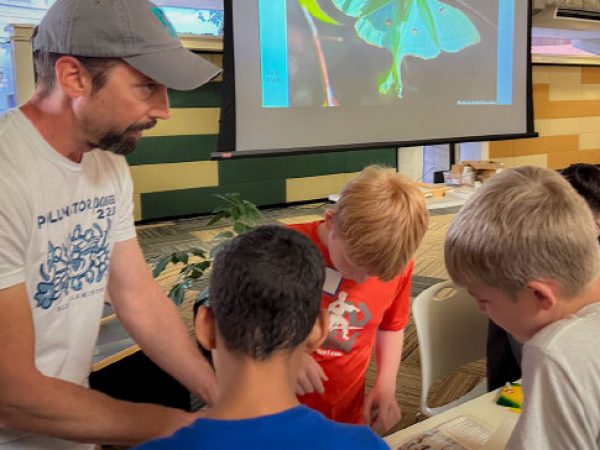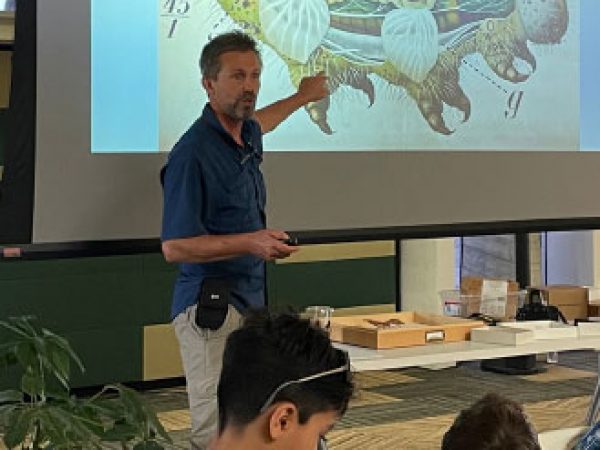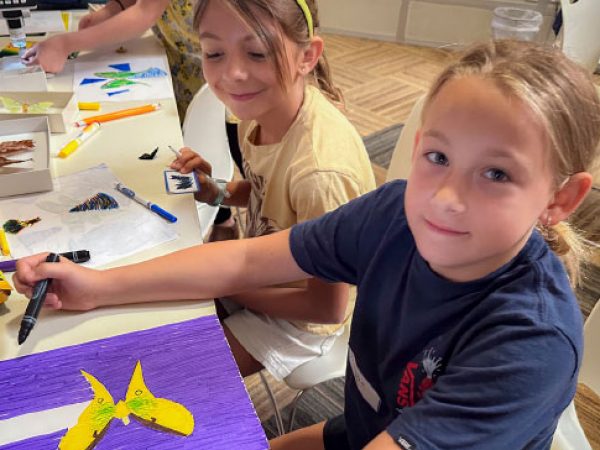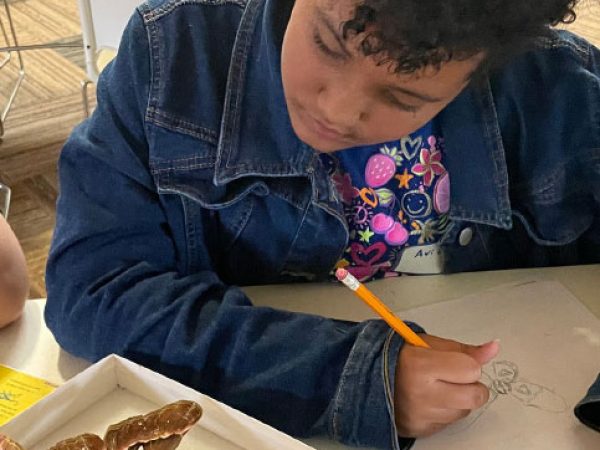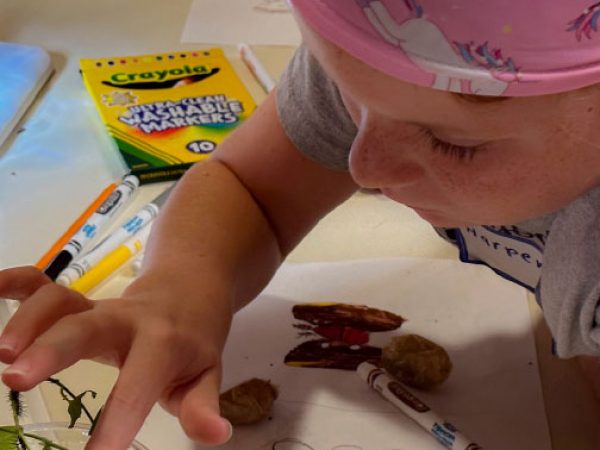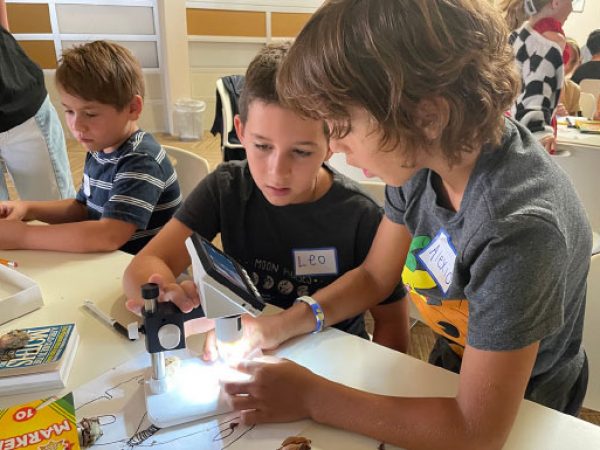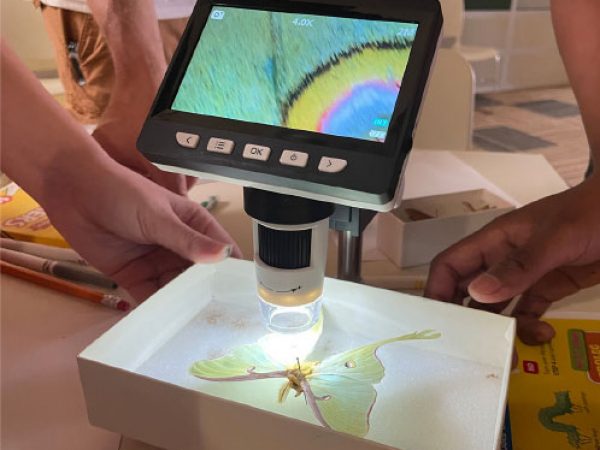Recently, we conducted a hands-on science event at the Florida Institute for Human and Machine Cognition (IHMC) in Ocala, about an hour south of Gainesville. One of us (Sourakov) already had a talk prepared about moth biology in conjunction with the launch of his 2022 book, The Lives of Moths, so we decided to focus on moths.
The setup: The Science Saturdays workshops at the IHMC are 90-minute-long sessions for kids of 3rd-4th and 5th-6th grade. In order for the sessions to be age appropriate and properly challenging, 3rd and 4th graders participate in a different session from the 5th and 6th graders. The traditional talk format, which most scientists are used to, does not work because of attention span issues related to prolonged listening, especially among 3rd and 4th graders. In order to make science fun, it is important for the learning approach to be hands-on.
 McGuire Center staff member, Matthew Standridge, showing caterpillars to the workshop participants
McGuire Center staff member, Matthew Standridge, showing caterpillars to the workshop participants During the workshop, we covered not only diversity of moths, but also their anatomy and the secrets of their metamorphosis.
During the workshop, we covered not only diversity of moths, but also their anatomy and the secrets of their metamorphosis. Caterpillars, like those of the Zebra Longwing butterfly, were a big hit, especially when viewed under the microscope.
Caterpillars, like those of the Zebra Longwing butterfly, were a big hit, especially when viewed under the microscope.
As the date approached, over 30 kids registered for each workshop session, with more on the waiting list. When they arrived, the kids in each session were divided into 6 groups of four or five students each, sitting at separate tables, ready for hands-on activities. At each table there was also a high school student “assistant to the instructors” whose role was to facilitate the activities at her/his table while allowing the younger participants to explore and learn in their own way.
Scientific illustration: In addition to the lecture about moth biology, we brought a number of spread moths and caterpillars. After a discussion (for about 15 minutes) of moth diversity, each table received one Atlas and one Luna moth in a unit tray. The task was to do a scientific illustration emphasizing the differences between the two species. Then we walked around, providing feedback on their drawings. Many of the drawings were surprisingly excellent and extremely diverse, ranging in style from “Picassos” to “Salvador Dalis.” We explained why scientific illustration leads to improved observational skills, compared to merely looking at a specimen or photograph.
Functional morphology: Then, 15-20 minutes later, we returned to the lecture/discussion mode for another 20 minutes. This time, we talked about other cool things moths do, such as how different species avoid predation. We brought their drawings into the discussion. The fact that the Luna moths have tails, while the Atlas moths don’t, relates to their defenses against bats. These were very well-informed kids, but there is always more that one can say about moths – the subject offers inexhaustible opportunities for teaching science.
Microcosmos: The next exercise involved looking at the moth world under microscopes. There are excellent and relatively inexpensive digital scopes equipped with screens that one can buy online for about $30 each. Six such scopes were purchased for the event, one for each table. This opened a tremendous world of wonder for the kids, who suddenly discovered that even a tiny moth which one can retrieve from a chandelier in one’s home, or a caterpillar, represents a world of diverse and unfamiliar-looking shapes and colors. We distributed smaller moths in small trays that easily fit under microscopes. Their task was to draw scales on wings, but they also got to view eyes, proboscis, antennae, and legs up close.
 During the workshop, participants were able get up-close and personal with all stages of Lepidoptera development.
During the workshop, participants were able get up-close and personal with all stages of Lepidoptera development. Inexpensive digital microscopes equipped with screens and lights can provide a great educational tool for moth workshops.
Inexpensive digital microscopes equipped with screens and lights can provide a great educational tool for moth workshops. Looking at scales that cover moth wings and form spectacular eyespots of the Luna Moth.
Looking at scales that cover moth wings and form spectacular eyespots of the Luna Moth.
Yucky stuff: One shouldn’t underestimate the attractiveness of “yuckyness” to kids. After we talked (during the next return to the lecture mode) about silk production by caterpillars, we stopped to distribute Luna Moth cocoons that we brought with us. We also had various live caterpillars on their preferred food sources, in clear plastic cups with clear lids with small holes for air circulation. Their mouth parts, spines, and poop (the technical name of which is “frass”) were a real hit with the kids – especially the frass, and especially when examined under a microscope. After each group finished observing their live caterpillars, they traded with another group, for another type of caterpillar. This topic also segues well into caterpillar anatomy.
Take home messages: The final stretch of the presentation led us into a discussion of the ecological importance of moths and the perils of their recently observed decline. We brought several collection drawers showcasing moths and other insects that the participants (and their parents) got to admire as they were leaving. We also talked briefly about iNaturalist and citizen science and how kids and their families can engage in observing moths at home.
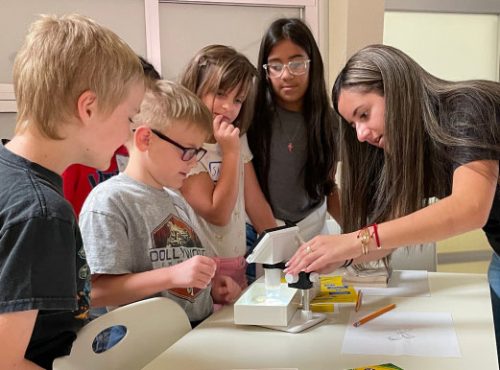
Acknowledgements: Here we provide a few photos from this event, but you can visit Science Saturdays – IHMC | Institute for Human & Machine Cognition website for more information and photo galleries. We are grateful to IHMC for providing the venue and to the student volunteers from the Ocala high schools for their help during the event. Having one such volunteer at each table is essential for ensuring that the workshop goes smoothly and that kids get the help they may need.
This post was originally published in the News of the Lepidopterists’ Society, Winter 2023 issue.
